Communication Culture Change: A Training Plan for Opal-Mart Managers
VerifiedAdded on 2021/05/30
|16
|3021
|34
Report
AI Summary
This report presents a comprehensive communication culture change training plan designed for the senior managers of Opal-Mart, Australia. The primary objective is to enhance their communication, negotiation, and conflict resolution skills to improve workforce efficiency and address communication barriers within the organization. The report provides a detailed research background, scope, and rationale, highlighting the need for improved information flow and conflict management. It outlines a training plan that includes a communication training philosophy, overview of contents, timeframe, and delivery mode, as well as the benefits of the proposed training for the target audience. The training aims to equip senior managers with the necessary skills to foster a positive work environment, resolve conflicts, and improve customer satisfaction. By addressing issues like ineffective meetings, cross-cultural communication problems, and customer complaints, the training seeks to create a more cohesive and productive workplace.
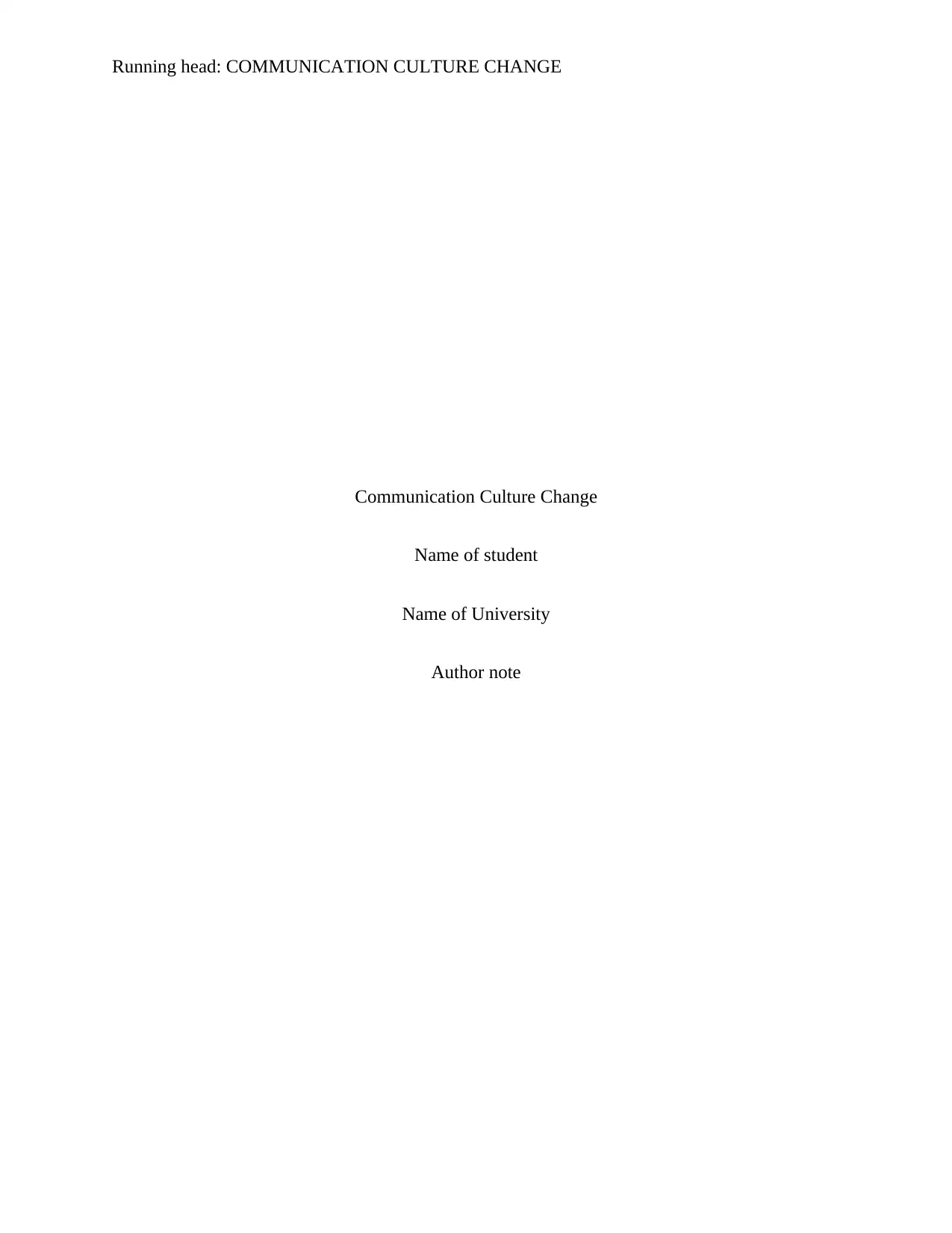
Running head: COMMUNICATION CULTURE CHANGE
Communication Culture Change
Name of student
Name of University
Author note
Communication Culture Change
Name of student
Name of University
Author note
Paraphrase This Document
Need a fresh take? Get an instant paraphrase of this document with our AI Paraphraser
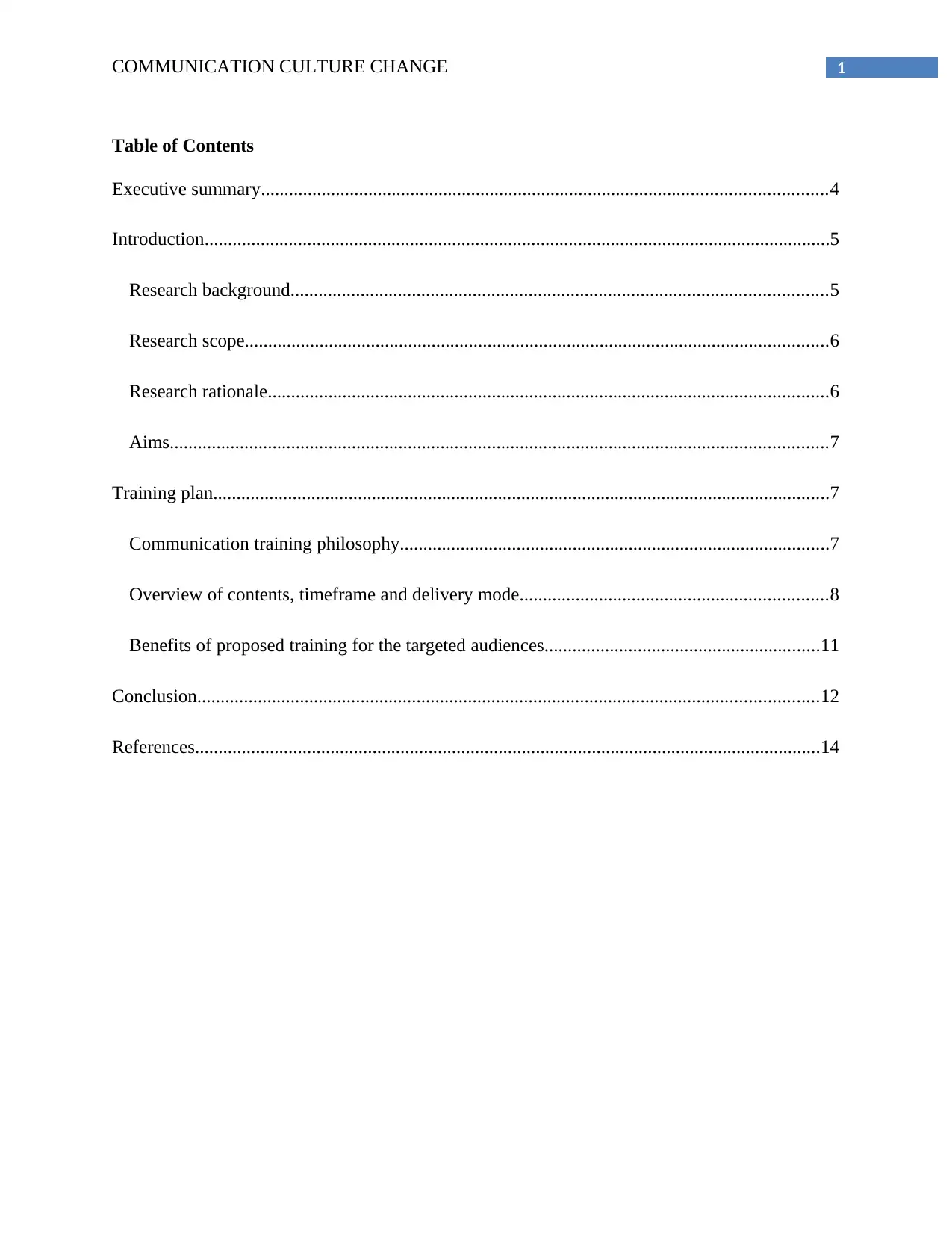
1COMMUNICATION CULTURE CHANGE
Table of Contents
Executive summary.........................................................................................................................4
Introduction......................................................................................................................................5
Research background...................................................................................................................5
Research scope.............................................................................................................................6
Research rationale........................................................................................................................6
Aims.............................................................................................................................................7
Training plan....................................................................................................................................7
Communication training philosophy............................................................................................7
Overview of contents, timeframe and delivery mode..................................................................8
Benefits of proposed training for the targeted audiences...........................................................11
Conclusion.....................................................................................................................................12
References......................................................................................................................................14
Table of Contents
Executive summary.........................................................................................................................4
Introduction......................................................................................................................................5
Research background...................................................................................................................5
Research scope.............................................................................................................................6
Research rationale........................................................................................................................6
Aims.............................................................................................................................................7
Training plan....................................................................................................................................7
Communication training philosophy............................................................................................7
Overview of contents, timeframe and delivery mode..................................................................8
Benefits of proposed training for the targeted audiences...........................................................11
Conclusion.....................................................................................................................................12
References......................................................................................................................................14

2COMMUNICATION CULTURE CHANGE
Executive summary
Within the organization, the communication training was prepared for the senior
managers of Opal-Mart for enhancing their listening, influential, negotiation, speaking,
interacting and assertiveness skills. This helped in overcoming the issues related to effective
communication and even maintained consistency between the sub groups of the organization.
The communication level improved between the individuals working at the different sub cultures
to meet the needs and requirements along with the mission and goals of the organization. The
communication training developed for the mangers of the organization also developed the ability
to perceive the ways individuals and subgroups managed to interact with each other to develop
interventions across Opal-Mart, Australia. The training service was credible enough because of
its ability to improve the skills and workforce functioning and even allowing the managers to
focus on the area of resolving conflicts during meetings and within the workplace.
Executive summary
Within the organization, the communication training was prepared for the senior
managers of Opal-Mart for enhancing their listening, influential, negotiation, speaking,
interacting and assertiveness skills. This helped in overcoming the issues related to effective
communication and even maintained consistency between the sub groups of the organization.
The communication level improved between the individuals working at the different sub cultures
to meet the needs and requirements along with the mission and goals of the organization. The
communication training developed for the mangers of the organization also developed the ability
to perceive the ways individuals and subgroups managed to interact with each other to develop
interventions across Opal-Mart, Australia. The training service was credible enough because of
its ability to improve the skills and workforce functioning and even allowing the managers to
focus on the area of resolving conflicts during meetings and within the workplace.
⊘ This is a preview!⊘
Do you want full access?
Subscribe today to unlock all pages.

Trusted by 1+ million students worldwide
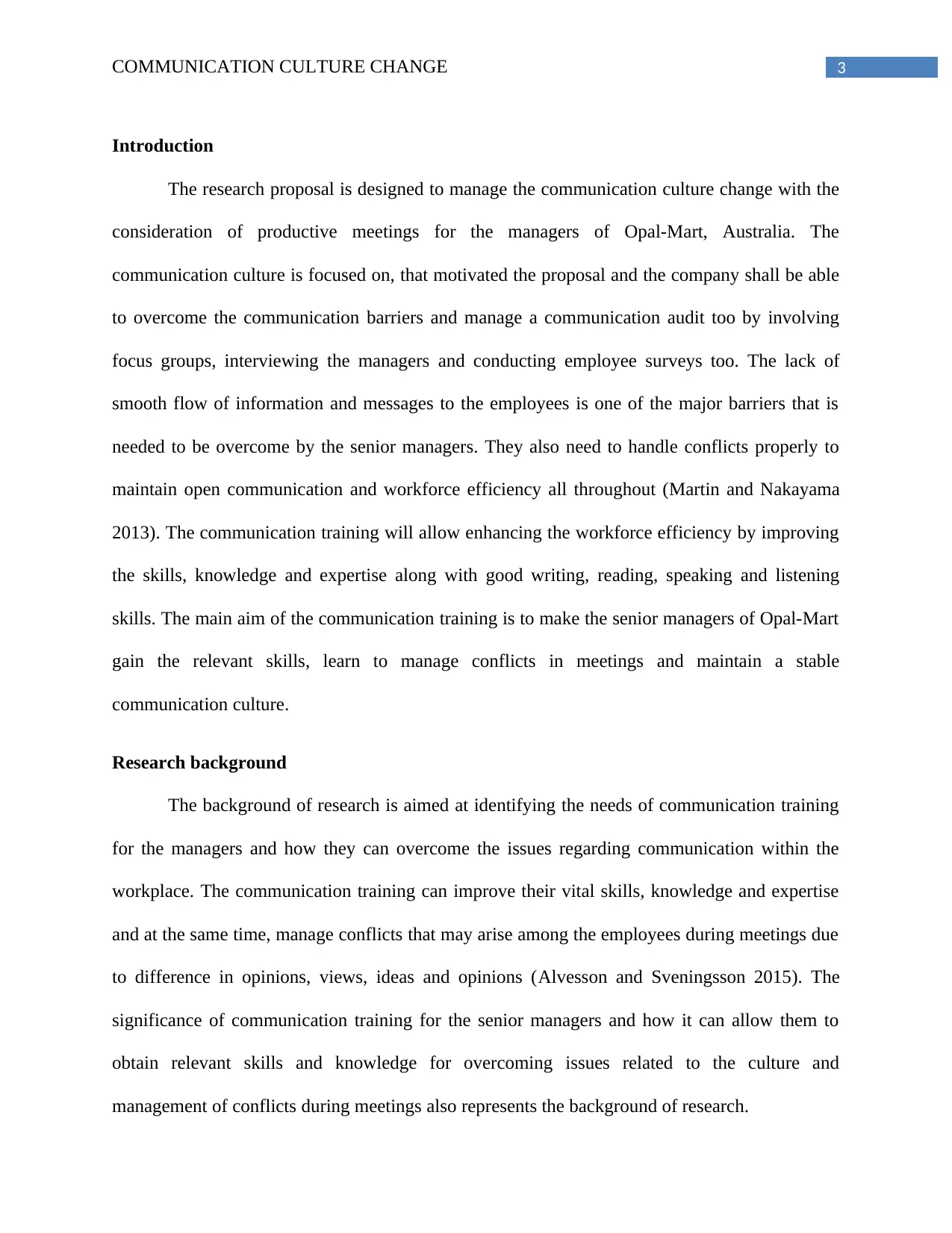
3COMMUNICATION CULTURE CHANGE
Introduction
The research proposal is designed to manage the communication culture change with the
consideration of productive meetings for the managers of Opal-Mart, Australia. The
communication culture is focused on, that motivated the proposal and the company shall be able
to overcome the communication barriers and manage a communication audit too by involving
focus groups, interviewing the managers and conducting employee surveys too. The lack of
smooth flow of information and messages to the employees is one of the major barriers that is
needed to be overcome by the senior managers. They also need to handle conflicts properly to
maintain open communication and workforce efficiency all throughout (Martin and Nakayama
2013). The communication training will allow enhancing the workforce efficiency by improving
the skills, knowledge and expertise along with good writing, reading, speaking and listening
skills. The main aim of the communication training is to make the senior managers of Opal-Mart
gain the relevant skills, learn to manage conflicts in meetings and maintain a stable
communication culture.
Research background
The background of research is aimed at identifying the needs of communication training
for the managers and how they can overcome the issues regarding communication within the
workplace. The communication training can improve their vital skills, knowledge and expertise
and at the same time, manage conflicts that may arise among the employees during meetings due
to difference in opinions, views, ideas and opinions (Alvesson and Sveningsson 2015). The
significance of communication training for the senior managers and how it can allow them to
obtain relevant skills and knowledge for overcoming issues related to the culture and
management of conflicts during meetings also represents the background of research.
Introduction
The research proposal is designed to manage the communication culture change with the
consideration of productive meetings for the managers of Opal-Mart, Australia. The
communication culture is focused on, that motivated the proposal and the company shall be able
to overcome the communication barriers and manage a communication audit too by involving
focus groups, interviewing the managers and conducting employee surveys too. The lack of
smooth flow of information and messages to the employees is one of the major barriers that is
needed to be overcome by the senior managers. They also need to handle conflicts properly to
maintain open communication and workforce efficiency all throughout (Martin and Nakayama
2013). The communication training will allow enhancing the workforce efficiency by improving
the skills, knowledge and expertise along with good writing, reading, speaking and listening
skills. The main aim of the communication training is to make the senior managers of Opal-Mart
gain the relevant skills, learn to manage conflicts in meetings and maintain a stable
communication culture.
Research background
The background of research is aimed at identifying the needs of communication training
for the managers and how they can overcome the issues regarding communication within the
workplace. The communication training can improve their vital skills, knowledge and expertise
and at the same time, manage conflicts that may arise among the employees during meetings due
to difference in opinions, views, ideas and opinions (Alvesson and Sveningsson 2015). The
significance of communication training for the senior managers and how it can allow them to
obtain relevant skills and knowledge for overcoming issues related to the culture and
management of conflicts during meetings also represents the background of research.
Paraphrase This Document
Need a fresh take? Get an instant paraphrase of this document with our AI Paraphraser
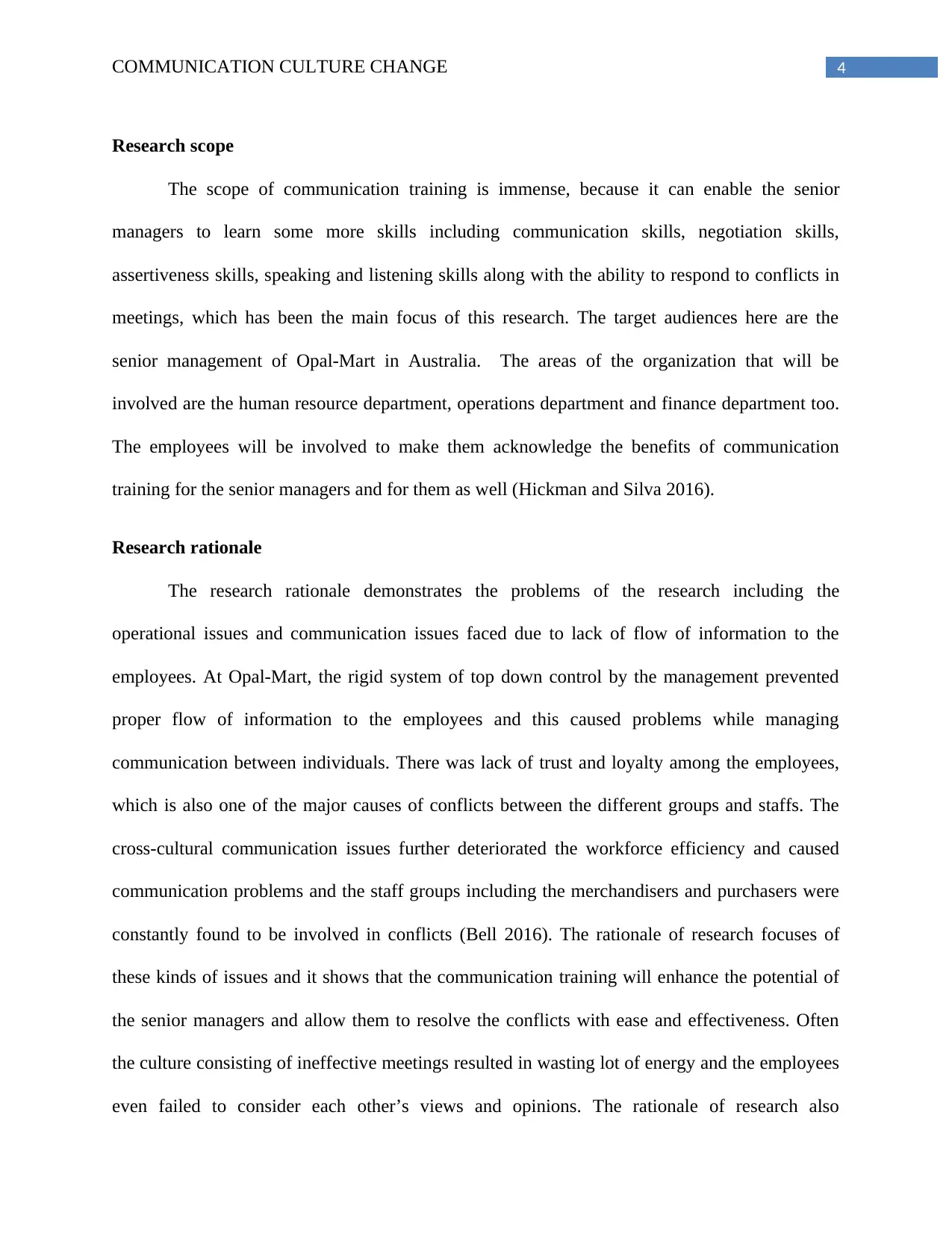
4COMMUNICATION CULTURE CHANGE
Research scope
The scope of communication training is immense, because it can enable the senior
managers to learn some more skills including communication skills, negotiation skills,
assertiveness skills, speaking and listening skills along with the ability to respond to conflicts in
meetings, which has been the main focus of this research. The target audiences here are the
senior management of Opal-Mart in Australia. The areas of the organization that will be
involved are the human resource department, operations department and finance department too.
The employees will be involved to make them acknowledge the benefits of communication
training for the senior managers and for them as well (Hickman and Silva 2016).
Research rationale
The research rationale demonstrates the problems of the research including the
operational issues and communication issues faced due to lack of flow of information to the
employees. At Opal-Mart, the rigid system of top down control by the management prevented
proper flow of information to the employees and this caused problems while managing
communication between individuals. There was lack of trust and loyalty among the employees,
which is also one of the major causes of conflicts between the different groups and staffs. The
cross-cultural communication issues further deteriorated the workforce efficiency and caused
communication problems and the staff groups including the merchandisers and purchasers were
constantly found to be involved in conflicts (Bell 2016). The rationale of research focuses of
these kinds of issues and it shows that the communication training will enhance the potential of
the senior managers and allow them to resolve the conflicts with ease and effectiveness. Often
the culture consisting of ineffective meetings resulted in wasting lot of energy and the employees
even failed to consider each other’s views and opinions. The rationale of research also
Research scope
The scope of communication training is immense, because it can enable the senior
managers to learn some more skills including communication skills, negotiation skills,
assertiveness skills, speaking and listening skills along with the ability to respond to conflicts in
meetings, which has been the main focus of this research. The target audiences here are the
senior management of Opal-Mart in Australia. The areas of the organization that will be
involved are the human resource department, operations department and finance department too.
The employees will be involved to make them acknowledge the benefits of communication
training for the senior managers and for them as well (Hickman and Silva 2016).
Research rationale
The research rationale demonstrates the problems of the research including the
operational issues and communication issues faced due to lack of flow of information to the
employees. At Opal-Mart, the rigid system of top down control by the management prevented
proper flow of information to the employees and this caused problems while managing
communication between individuals. There was lack of trust and loyalty among the employees,
which is also one of the major causes of conflicts between the different groups and staffs. The
cross-cultural communication issues further deteriorated the workforce efficiency and caused
communication problems and the staff groups including the merchandisers and purchasers were
constantly found to be involved in conflicts (Bell 2016). The rationale of research focuses of
these kinds of issues and it shows that the communication training will enhance the potential of
the senior managers and allow them to resolve the conflicts with ease and effectiveness. Often
the culture consisting of ineffective meetings resulted in wasting lot of energy and the employees
even failed to consider each other’s views and opinions. The rationale of research also
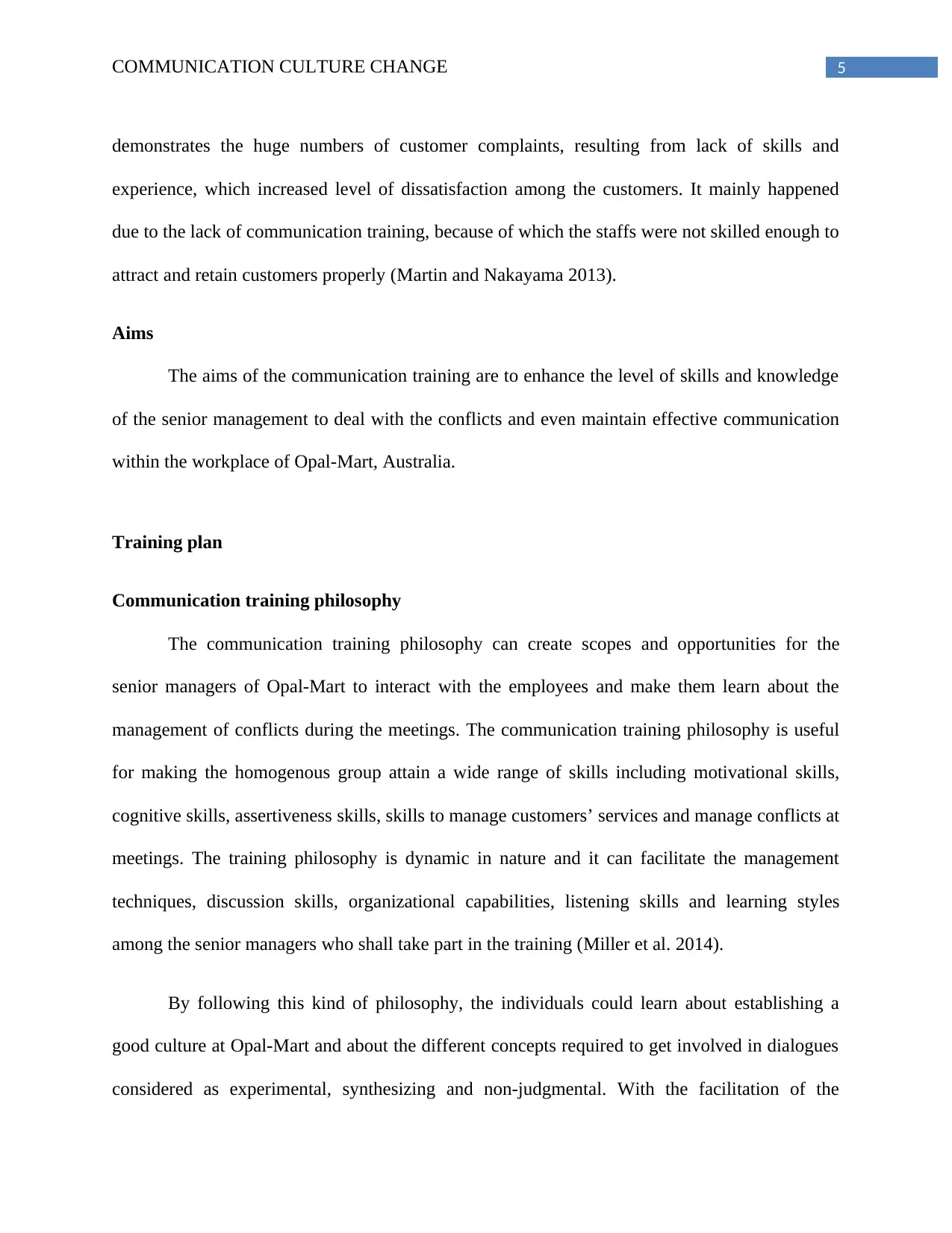
5COMMUNICATION CULTURE CHANGE
demonstrates the huge numbers of customer complaints, resulting from lack of skills and
experience, which increased level of dissatisfaction among the customers. It mainly happened
due to the lack of communication training, because of which the staffs were not skilled enough to
attract and retain customers properly (Martin and Nakayama 2013).
Aims
The aims of the communication training are to enhance the level of skills and knowledge
of the senior management to deal with the conflicts and even maintain effective communication
within the workplace of Opal-Mart, Australia.
Training plan
Communication training philosophy
The communication training philosophy can create scopes and opportunities for the
senior managers of Opal-Mart to interact with the employees and make them learn about the
management of conflicts during the meetings. The communication training philosophy is useful
for making the homogenous group attain a wide range of skills including motivational skills,
cognitive skills, assertiveness skills, skills to manage customers’ services and manage conflicts at
meetings. The training philosophy is dynamic in nature and it can facilitate the management
techniques, discussion skills, organizational capabilities, listening skills and learning styles
among the senior managers who shall take part in the training (Miller et al. 2014).
By following this kind of philosophy, the individuals could learn about establishing a
good culture at Opal-Mart and about the different concepts required to get involved in dialogues
considered as experimental, synthesizing and non-judgmental. With the facilitation of the
demonstrates the huge numbers of customer complaints, resulting from lack of skills and
experience, which increased level of dissatisfaction among the customers. It mainly happened
due to the lack of communication training, because of which the staffs were not skilled enough to
attract and retain customers properly (Martin and Nakayama 2013).
Aims
The aims of the communication training are to enhance the level of skills and knowledge
of the senior management to deal with the conflicts and even maintain effective communication
within the workplace of Opal-Mart, Australia.
Training plan
Communication training philosophy
The communication training philosophy can create scopes and opportunities for the
senior managers of Opal-Mart to interact with the employees and make them learn about the
management of conflicts during the meetings. The communication training philosophy is useful
for making the homogenous group attain a wide range of skills including motivational skills,
cognitive skills, assertiveness skills, skills to manage customers’ services and manage conflicts at
meetings. The training philosophy is dynamic in nature and it can facilitate the management
techniques, discussion skills, organizational capabilities, listening skills and learning styles
among the senior managers who shall take part in the training (Miller et al. 2014).
By following this kind of philosophy, the individuals could learn about establishing a
good culture at Opal-Mart and about the different concepts required to get involved in dialogues
considered as experimental, synthesizing and non-judgmental. With the facilitation of the
⊘ This is a preview!⊘
Do you want full access?
Subscribe today to unlock all pages.

Trusted by 1+ million students worldwide
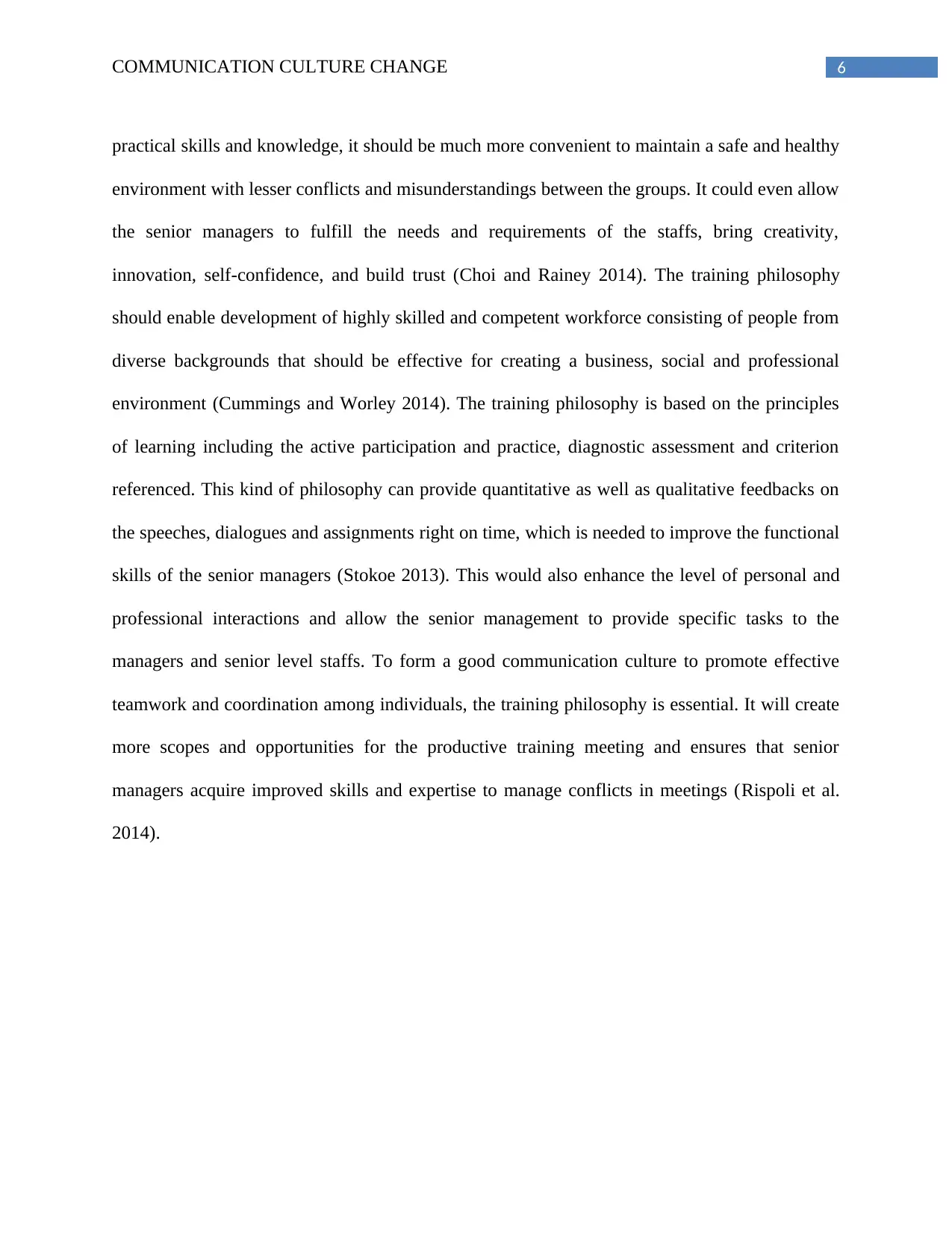
6COMMUNICATION CULTURE CHANGE
practical skills and knowledge, it should be much more convenient to maintain a safe and healthy
environment with lesser conflicts and misunderstandings between the groups. It could even allow
the senior managers to fulfill the needs and requirements of the staffs, bring creativity,
innovation, self-confidence, and build trust (Choi and Rainey 2014). The training philosophy
should enable development of highly skilled and competent workforce consisting of people from
diverse backgrounds that should be effective for creating a business, social and professional
environment (Cummings and Worley 2014). The training philosophy is based on the principles
of learning including the active participation and practice, diagnostic assessment and criterion
referenced. This kind of philosophy can provide quantitative as well as qualitative feedbacks on
the speeches, dialogues and assignments right on time, which is needed to improve the functional
skills of the senior managers (Stokoe 2013). This would also enhance the level of personal and
professional interactions and allow the senior management to provide specific tasks to the
managers and senior level staffs. To form a good communication culture to promote effective
teamwork and coordination among individuals, the training philosophy is essential. It will create
more scopes and opportunities for the productive training meeting and ensures that senior
managers acquire improved skills and expertise to manage conflicts in meetings (Rispoli et al.
2014).
practical skills and knowledge, it should be much more convenient to maintain a safe and healthy
environment with lesser conflicts and misunderstandings between the groups. It could even allow
the senior managers to fulfill the needs and requirements of the staffs, bring creativity,
innovation, self-confidence, and build trust (Choi and Rainey 2014). The training philosophy
should enable development of highly skilled and competent workforce consisting of people from
diverse backgrounds that should be effective for creating a business, social and professional
environment (Cummings and Worley 2014). The training philosophy is based on the principles
of learning including the active participation and practice, diagnostic assessment and criterion
referenced. This kind of philosophy can provide quantitative as well as qualitative feedbacks on
the speeches, dialogues and assignments right on time, which is needed to improve the functional
skills of the senior managers (Stokoe 2013). This would also enhance the level of personal and
professional interactions and allow the senior management to provide specific tasks to the
managers and senior level staffs. To form a good communication culture to promote effective
teamwork and coordination among individuals, the training philosophy is essential. It will create
more scopes and opportunities for the productive training meeting and ensures that senior
managers acquire improved skills and expertise to manage conflicts in meetings (Rispoli et al.
2014).
Paraphrase This Document
Need a fresh take? Get an instant paraphrase of this document with our AI Paraphraser
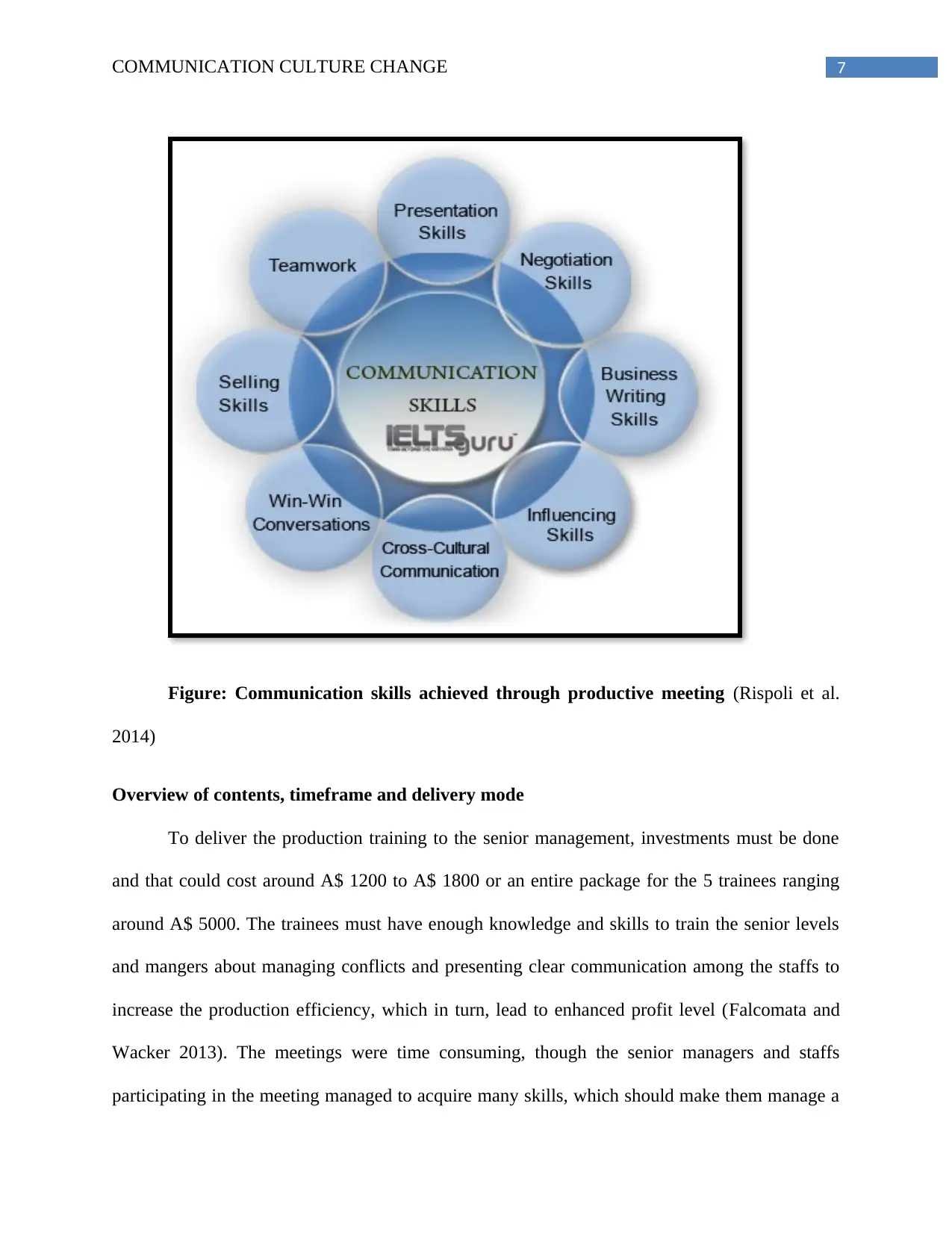
7COMMUNICATION CULTURE CHANGE
Figure: Communication skills achieved through productive meeting (Rispoli et al.
2014)
Overview of contents, timeframe and delivery mode
To deliver the production training to the senior management, investments must be done
and that could cost around A$ 1200 to A$ 1800 or an entire package for the 5 trainees ranging
around A$ 5000. The trainees must have enough knowledge and skills to train the senior levels
and mangers about managing conflicts and presenting clear communication among the staffs to
increase the production efficiency, which in turn, lead to enhanced profit level (Falcomata and
Wacker 2013). The meetings were time consuming, though the senior managers and staffs
participating in the meeting managed to acquire many skills, which should make them manage a
Figure: Communication skills achieved through productive meeting (Rispoli et al.
2014)
Overview of contents, timeframe and delivery mode
To deliver the production training to the senior management, investments must be done
and that could cost around A$ 1200 to A$ 1800 or an entire package for the 5 trainees ranging
around A$ 5000. The trainees must have enough knowledge and skills to train the senior levels
and mangers about managing conflicts and presenting clear communication among the staffs to
increase the production efficiency, which in turn, lead to enhanced profit level (Falcomata and
Wacker 2013). The meetings were time consuming, though the senior managers and staffs
participating in the meeting managed to acquire many skills, which should make them manage a
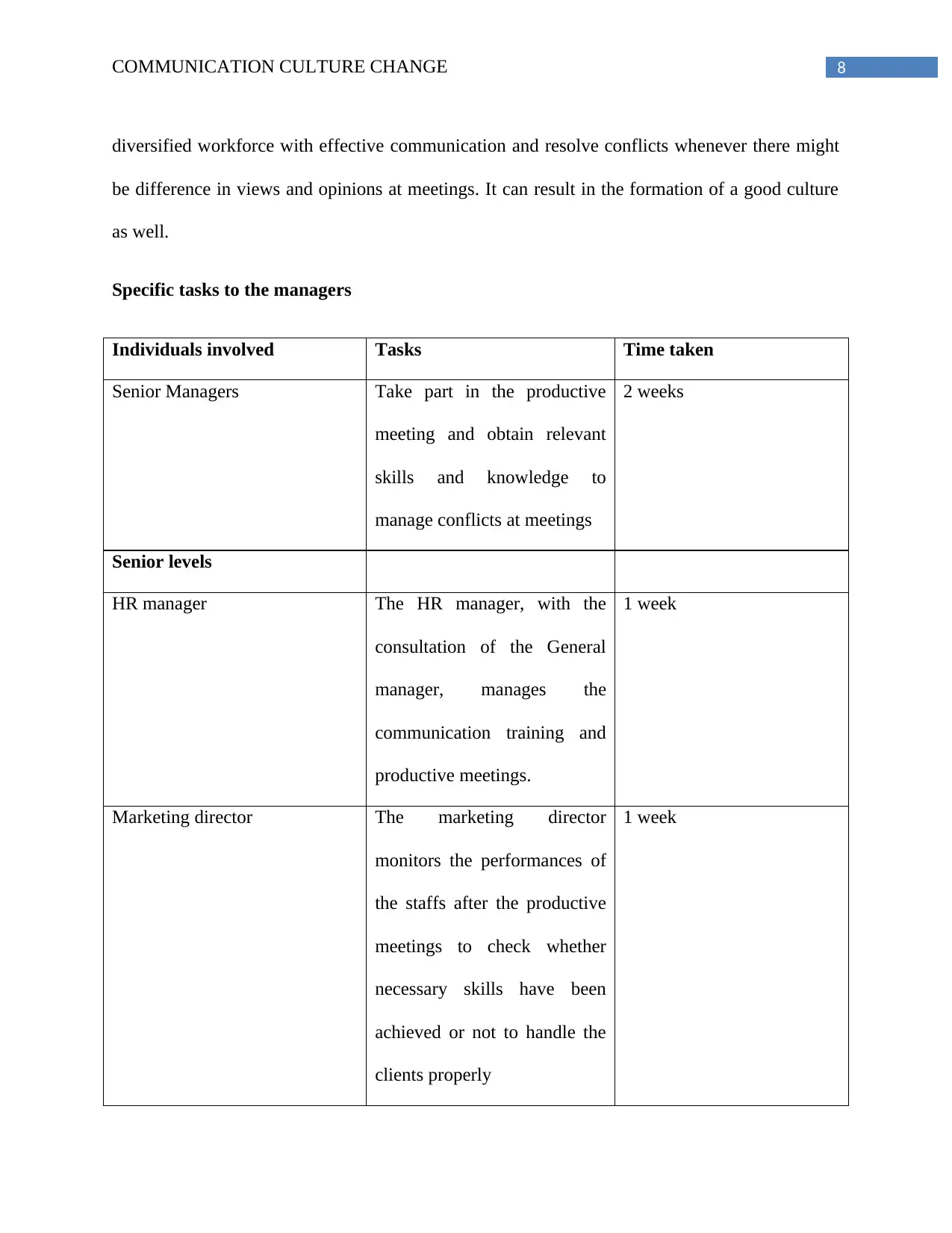
8COMMUNICATION CULTURE CHANGE
diversified workforce with effective communication and resolve conflicts whenever there might
be difference in views and opinions at meetings. It can result in the formation of a good culture
as well.
Specific tasks to the managers
Individuals involved Tasks Time taken
Senior Managers Take part in the productive
meeting and obtain relevant
skills and knowledge to
manage conflicts at meetings
2 weeks
Senior levels
HR manager The HR manager, with the
consultation of the General
manager, manages the
communication training and
productive meetings.
1 week
Marketing director The marketing director
monitors the performances of
the staffs after the productive
meetings to check whether
necessary skills have been
achieved or not to handle the
clients properly
1 week
diversified workforce with effective communication and resolve conflicts whenever there might
be difference in views and opinions at meetings. It can result in the formation of a good culture
as well.
Specific tasks to the managers
Individuals involved Tasks Time taken
Senior Managers Take part in the productive
meeting and obtain relevant
skills and knowledge to
manage conflicts at meetings
2 weeks
Senior levels
HR manager The HR manager, with the
consultation of the General
manager, manages the
communication training and
productive meetings.
1 week
Marketing director The marketing director
monitors the performances of
the staffs after the productive
meetings to check whether
necessary skills have been
achieved or not to handle the
clients properly
1 week
⊘ This is a preview!⊘
Do you want full access?
Subscribe today to unlock all pages.

Trusted by 1+ million students worldwide

9COMMUNICATION CULTURE CHANGE
Staffs The staffs should consider the
views and opinions of others
too and interact with each
other to form a positive
culture and work
collaboratively. To acquire the
skills, they need to participate
in the meetings and even learn
to manage conflicts through
consideration of each other’s
ideas and opinions.
1 week
Benefits of giving specific tasks to the senior levels and managers
The senior levels and managers will be able to manage the staffs properly and prevent
conflicts from arising during meetings at Opal-Mart, Australia.
With the conflicts being resolved, there would be more chances of creating a diverse
workforce and an appropriate culture at Opal-Mart, Australia.
The HR manager would manage productive communication training to improve the skills
and knowledge among the staffs and make them learn to communicate with others,
thereby consider their views and opinions too.
Staffs The staffs should consider the
views and opinions of others
too and interact with each
other to form a positive
culture and work
collaboratively. To acquire the
skills, they need to participate
in the meetings and even learn
to manage conflicts through
consideration of each other’s
ideas and opinions.
1 week
Benefits of giving specific tasks to the senior levels and managers
The senior levels and managers will be able to manage the staffs properly and prevent
conflicts from arising during meetings at Opal-Mart, Australia.
With the conflicts being resolved, there would be more chances of creating a diverse
workforce and an appropriate culture at Opal-Mart, Australia.
The HR manager would manage productive communication training to improve the skills
and knowledge among the staffs and make them learn to communicate with others,
thereby consider their views and opinions too.
Paraphrase This Document
Need a fresh take? Get an instant paraphrase of this document with our AI Paraphraser
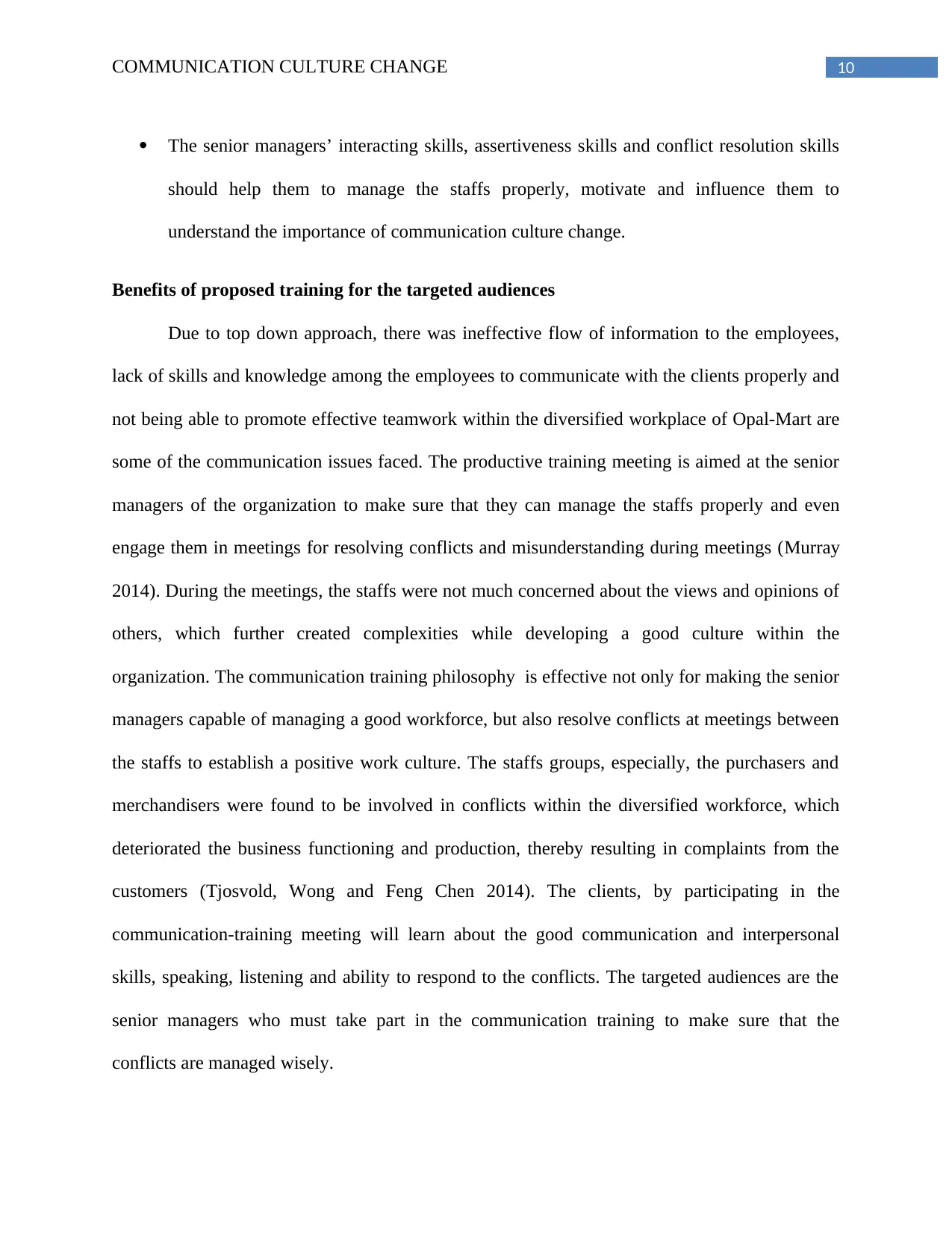
10COMMUNICATION CULTURE CHANGE
The senior managers’ interacting skills, assertiveness skills and conflict resolution skills
should help them to manage the staffs properly, motivate and influence them to
understand the importance of communication culture change.
Benefits of proposed training for the targeted audiences
Due to top down approach, there was ineffective flow of information to the employees,
lack of skills and knowledge among the employees to communicate with the clients properly and
not being able to promote effective teamwork within the diversified workplace of Opal-Mart are
some of the communication issues faced. The productive training meeting is aimed at the senior
managers of the organization to make sure that they can manage the staffs properly and even
engage them in meetings for resolving conflicts and misunderstanding during meetings (Murray
2014). During the meetings, the staffs were not much concerned about the views and opinions of
others, which further created complexities while developing a good culture within the
organization. The communication training philosophy is effective not only for making the senior
managers capable of managing a good workforce, but also resolve conflicts at meetings between
the staffs to establish a positive work culture. The staffs groups, especially, the purchasers and
merchandisers were found to be involved in conflicts within the diversified workforce, which
deteriorated the business functioning and production, thereby resulting in complaints from the
customers (Tjosvold, Wong and Feng Chen 2014). The clients, by participating in the
communication-training meeting will learn about the good communication and interpersonal
skills, speaking, listening and ability to respond to the conflicts. The targeted audiences are the
senior managers who must take part in the communication training to make sure that the
conflicts are managed wisely.
The senior managers’ interacting skills, assertiveness skills and conflict resolution skills
should help them to manage the staffs properly, motivate and influence them to
understand the importance of communication culture change.
Benefits of proposed training for the targeted audiences
Due to top down approach, there was ineffective flow of information to the employees,
lack of skills and knowledge among the employees to communicate with the clients properly and
not being able to promote effective teamwork within the diversified workplace of Opal-Mart are
some of the communication issues faced. The productive training meeting is aimed at the senior
managers of the organization to make sure that they can manage the staffs properly and even
engage them in meetings for resolving conflicts and misunderstanding during meetings (Murray
2014). During the meetings, the staffs were not much concerned about the views and opinions of
others, which further created complexities while developing a good culture within the
organization. The communication training philosophy is effective not only for making the senior
managers capable of managing a good workforce, but also resolve conflicts at meetings between
the staffs to establish a positive work culture. The staffs groups, especially, the purchasers and
merchandisers were found to be involved in conflicts within the diversified workforce, which
deteriorated the business functioning and production, thereby resulting in complaints from the
customers (Tjosvold, Wong and Feng Chen 2014). The clients, by participating in the
communication-training meeting will learn about the good communication and interpersonal
skills, speaking, listening and ability to respond to the conflicts. The targeted audiences are the
senior managers who must take part in the communication training to make sure that the
conflicts are managed wisely.

11COMMUNICATION CULTURE CHANGE
Figure: Benefits of communication training (Tjosvold, Wong and Feng Chen 2014)
The senior management would be able to know about the concerns of the managers,
staffs and create a diverse workforce. There were intercultural communication issues due to the
presence of individuals from different backgrounds and cultures, which resulted in
communication barriers and even lot of time and energy was wasted. The views and opinions
were different, which was one of the major causes of degrading the customers’ services and this
created tension between the purchasers and merchandisers (Clegg, Kornberger and Pitsis 2015).
The lack of skills among the staffs made them unable to carry out their roles and responsibilities
properly, which further deteriorated the business performance. The productive training to the
senior management could make the managers resolve conflicts among the staffs and groups at
Opal-Mart and promote a communication culture (Schlaerth, Ensari and Christian 2013). It is
necessary for establishing good relationships between the company and its customers and
improve the collaborative work through retention of trust and loyalty. The views and opinions
CommunicationtrainingPromotegoodcommunicationbetweenstaffsConsiderationofinnovativeviews,ideasandopinionsEstablishingapositivecultureRetentionoftrustandloyalty
Figure: Benefits of communication training (Tjosvold, Wong and Feng Chen 2014)
The senior management would be able to know about the concerns of the managers,
staffs and create a diverse workforce. There were intercultural communication issues due to the
presence of individuals from different backgrounds and cultures, which resulted in
communication barriers and even lot of time and energy was wasted. The views and opinions
were different, which was one of the major causes of degrading the customers’ services and this
created tension between the purchasers and merchandisers (Clegg, Kornberger and Pitsis 2015).
The lack of skills among the staffs made them unable to carry out their roles and responsibilities
properly, which further deteriorated the business performance. The productive training to the
senior management could make the managers resolve conflicts among the staffs and groups at
Opal-Mart and promote a communication culture (Schlaerth, Ensari and Christian 2013). It is
necessary for establishing good relationships between the company and its customers and
improve the collaborative work through retention of trust and loyalty. The views and opinions
CommunicationtrainingPromotegoodcommunicationbetweenstaffsConsiderationofinnovativeviews,ideasandopinionsEstablishingapositivecultureRetentionoftrustandloyalty
⊘ This is a preview!⊘
Do you want full access?
Subscribe today to unlock all pages.

Trusted by 1+ million students worldwide
1 out of 16
Related Documents
Your All-in-One AI-Powered Toolkit for Academic Success.
+13062052269
info@desklib.com
Available 24*7 on WhatsApp / Email
![[object Object]](/_next/static/media/star-bottom.7253800d.svg)
Unlock your academic potential
Copyright © 2020–2025 A2Z Services. All Rights Reserved. Developed and managed by ZUCOL.





